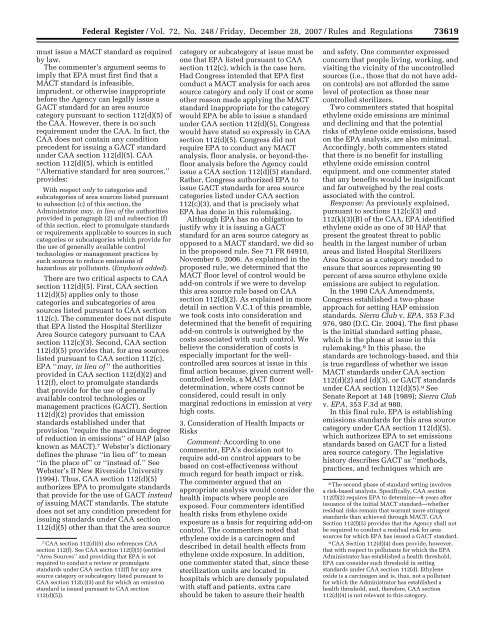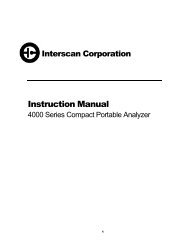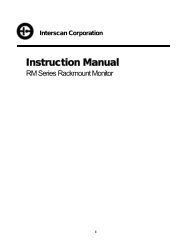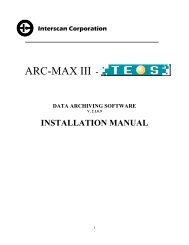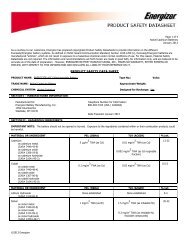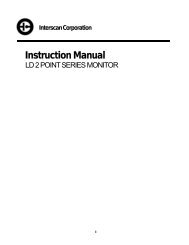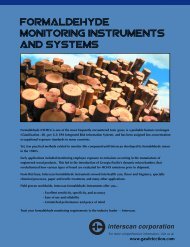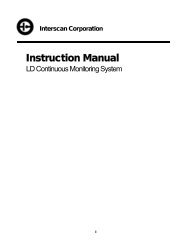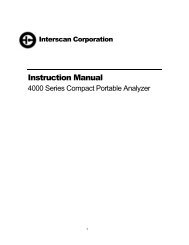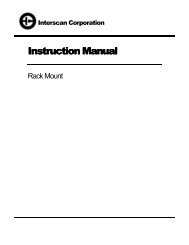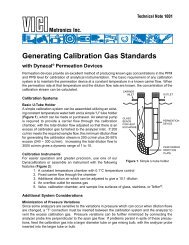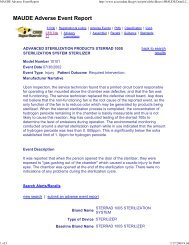Hospitals: Ethylene Oxide Sterilizers - US Environmental Protection ...
Hospitals: Ethylene Oxide Sterilizers - US Environmental Protection ...
Hospitals: Ethylene Oxide Sterilizers - US Environmental Protection ...
You also want an ePaper? Increase the reach of your titles
YUMPU automatically turns print PDFs into web optimized ePapers that Google loves.
Federal Register / Vol. 72, No. 248 / Friday, December 28, 2007 / Rules and Regulations73619pwalker on PROD1PC71 with RULESmust issue a MACT standard as requiredby law.The commenter’s argument seems toimply that EPA must first find that aMACT standard is infeasible,imprudent, or otherwise inappropriatebefore the Agency can legally issue aGACT standard for an area sourcecategory pursuant to section 112(d)(5) ofthe CAA. However, there is no suchrequirement under the CAA. In fact, theCAA does not contain any conditionprecedent for issuing a GACT standardunder CAA section 112(d)(5). CAAsection 112(d)(5), which is entitled‘‘Alternative standard for area sources,’’provides:With respect only to categories andsubcategories of area sources listed pursuantto subsection (c) of this section, theAdministrator may, in lieu of the authoritiesprovided in paragraph (2) and subsection (f)of this section, elect to promulgate standardsor requirements applicable to sources in suchcategories or subcategories which provide forthe use of generally available controltechnologies or management practices bysuch sources to reduce emissions ofhazardous air pollutants. (Emphasis added).There are two critical aspects to CAAsection 112(d)(5). First, CAA section112(d)(5) applies only to thosecategories and subcategories of areasources listed pursuant to CAA section112(c). The commenter does not disputethat EPA listed the Hospital SterilizerArea Source category pursuant to CAAsection 112(c)(3). Second, CAA section112(d)(5) provides that, for area sourceslisted pursuant to CAA section 112(c),EPA ‘‘may, in lieu of ’’ the authoritiesprovided in CAA section 112(d)(2) and112(f), elect to promulgate standardsthat provide for the use of generallyavailable control technologies ormanagement practices (GACT). Section112(d)(2) provides that emissionstandards established under thatprovision ‘‘require the maximum degreeof reduction in emissions’’ of HAP (alsoknown as MACT). 7 Webster’s dictionarydefines the phrase ‘‘in lieu of’’ to mean‘‘in the place of’’ or ‘‘instead of.’’ SeeWebster’s II New Riverside University(1994). Thus, CAA section 112(d)(5)authorizes EPA to promulgate standardsthat provide for the use of GACT insteadof issuing MACT standards. The statutedoes not set any condition precedent forissuing standards under CAA section112(d)(5) other than that the area source7 CAA section 112(d)(5) also references CAAsection 112(f). See CAA section 112(f)(5) (entitled‘‘Area Sources’’ and providing that EPA is notrequired to conduct a review or promulgatestandards under CAA section 112(f) for any areasource category or subcategory listed pursuant toCAA section 112(c)(3) and for which an emissionstandard is issued pursuant to CAA section112(d)(5)).category or subcategory at issue must beone that EPA listed pursuant to CAAsection 112(c), which is the case here.Had Congress intended that EPA firstconduct a MACT analysis for each areasource category and only if cost or someother reason made applying the MACTstandard inappropriate for the categorywould EPA be able to issue a standardunder CAA section 112(d)(5), Congresswould have stated so expressly in CAAsection 112(d)(5). Congress did notrequire EPA to conduct any MACTanalysis, floor analysis, or beyond-theflooranalysis before the Agency couldissue a CAA section 112(d)(5) standard.Rather, Congress authorized EPA toissue GACT standards for area sourcecategories listed under CAA section112(c)(3), and that is precisely whatEPA has done in this rulemaking.Although EPA has no obligation tojustify why it is issuing a GACTstandard for an area source category asopposed to a MACT standard, we did soin the proposed rule. See 71 FR 64910,November 6, 2006. As explained in theproposed rule, we determined that theMACT floor level of control would beadd-on controls if we were to developthis area source rule based on CAAsection 112(d)(2). As explained in moredetail in section V.C.1 of this preamble,we took costs into consideration anddetermined that the benefit of requiringadd-on controls is outweighed by thecosts associated with such control. Webelieve the consideration of costs isespecially important for the wellcontrolledarea sources at issue in thisfinal action because, given current wellcontrolledlevels, a MACT floordetermination, where costs cannot beconsidered, could result in onlymarginal reductions in emission at veryhigh costs.3. Consideration of Health Impacts orRisksComment: According to onecommenter, EPA’s decision not torequire add-on control appears to bebased on cost-effectiveness withoutmuch regard for heath impact or risk.The commenter argued that anappropriate analysis would consider thehealth impacts where people areexposed. Four commenters identifiedhealth risks from ethylene oxideexposure as a basis for requiring add-oncontrol. The commenters noted thatethylene oxide is a carcinogen anddescribed in detail health effects fromethylene oxide exposure. In addition,one commenter stated that, since thesesterilization units are located inhospitals which are densely populatedwith staff and patients, extra careshould be taken to assure their healthVerDate Aug2005 23:53 Dec 27, 2007 Jkt 214001 PO 00000 Frm 00047 Fmt 4700 Sfmt 4700 E:\FR\FM\28DER1.SGM 28DER1and safety. One commenter expressedconcern that people living, working, andvisiting the vicinity of the uncontrolledsources (i.e., those that do not have addoncontrols) are not afforded the samelevel of protection as those nearcontrolled sterilizers.Two commenters stated that hospitalethylene oxide emissions are minimaland declining and that the potentialrisks of ethylene oxide emissions, basedon the EPA analysis, are also minimal.Accordingly, both commenters statedthat there is no benefit for installingethylene oxide emission controlequipment, and one commenter statedthat any benefits would be insignificantand far outweighed by the real costsassociated with the control.Response: As previously explained,pursuant to sections 112(c)(3) and112(k)(3)(B) of the CAA, EPA identifiedethylene oxide as one of 30 HAP thatpresent the greatest threat to publichealth in the largest number of urbanareas and listed Hospital <strong>Sterilizers</strong>Area Source as a category needed toensure that sources representing 90percent of area source ethylene oxideemissions are subject to regulation.In the 1990 CAA Amendments,Congress established a two-phaseapproach for setting HAP emissionstandards. Sierra Club v. EPA, 353 F.3d976, 980 (D.C. Cir. 2004). The first phaseis the initial standard setting phase,which is the phase at issue in thisrulemaking. 8 In this phase, thestandards are technology-based, and thisis true regardless of whether we issueMACT standards under CAA section112(d)(2) and (d)(3), or GACT standardsunder CAA section 112(d)(5). 9 SeeSenate Report at 148 (1989); Sierra Clubv. EPA, 353 F.3d at 980.In this final rule, EPA is establishingemissions standards for this area sourcecategory under CAA section 112(d)(5),which authorizes EPA to set emissionsstandards based on GACT for a listedarea source category. The legislativehistory describes GACT as ‘‘methods,practices, and techniques which are8 The second phase of standard setting involvesa risk-based analysis. Specifically, CAA section112(f)(2) requires EPA to determine—8 years afterissuance of the initial MACT standard—whetherresidual risks remain that warrant more stringentstandards than achieved through MACT. CAASection 112(f)(5) provides that the Agency shall notbe required to conduct a residual risk for areasources for which EPA has issued a GACT standard.9 CAA Section 112(d)(4) does provide, however,that with respect to pollutants for which the EPAAdministrator has established a health threshold,EPA can consider such threshold in settingstandards under CAA section 112(d). <strong>Ethylene</strong>oxide is a carcinogen and is, thus, not a pollutantfor which the Administrator has established ahealth threshold, and, therefore, CAA section112(d)(4) is not relevant to this category.


